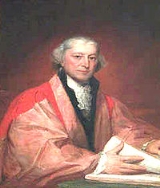
Johnson State College
Encyclopedia
Johnson State College is a small public liberal arts college
, founded in 1828 by John Chesamore at Johnson in the U.S. state of Vermont
. Johnson's president is Barbara E. Murphy
and its board chair is Gary M. Moore
.
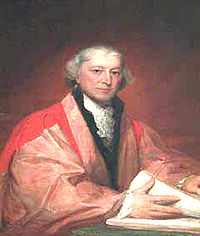 Both the college, and the town of Johnson are named for William Samuel Johnson
Both the college, and the town of Johnson are named for William Samuel Johnson
(1727-1819), American jurist, statesman and educator. The town of Johnson, and a part of neighboring Cambridge, Vermont together once made up the King's College Tract
, a land grant chartered by King George III in 1774 for the eventual expansion of King's College in New York, today's Columbia University. Following the Declaration of Independence, and the emergence of the Vermont Republic
, the town was instead granted to William Samuel Johnson by Vermont's Council of Censors in 1782. Johnson represented Connecticut in the Continental Congress, and argued for Vermont's admission to the federal Union. He later became president of Columbia University. John Chesamore founded Johnson State College as Johnson Academy, a grammar school instructing students in Greek, Latin, algerbra and geometry. In 1867 the school became a Vermont state "normal school
", a term based on the French école normale – a school to educate teachers. Early on Johnson embraced the ideas of learning from experience, and the role of the student in directing some part of their curriculum. The college was among the first Vermont universities to introduce electives. Through the early to mid-twentieth century Johnson emerged as a college of the liberal arts and natural sciences.
A commitment to educating the whole student in an interdisciplinary manner, begun in the 1920s and 1930s, set in place a history of bringing visiting poets, playwrights, politicians, and artists to the college. That tradition continues, bringing filmmakers, political and spiritual leaders, and artists. Recent visitors to the campus include Japanese and Cuban drummers, New Orleans jazz musicians, and Buddhist monks who installed an environmental art work at Lower Pond.
The original campus was built in the village of Johnson and over time, the college expanded; slowly building higher upon what is now called College Hill, finally settling upon a plateau above the village with a view of Sterling Mountain and the Sterling Mountain Range. Today the college is a part of the Vermont State Colleges
, a consortium of five colleges governed by a common board of trustees, chancellor, and Council of Presidents
, each college with its own president and deans.
(1859-1952) inform Johnson's emphasis on students' self evolution with emphasis on "learning by doing" and "learning by teaching." The college emphasizes the individual's civic contribution to their larger society.
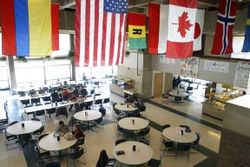
Graduate programs at Johnson include an M.F.A. in Studio Arts, a Master of Arts in Education, and Master of Arts in Counseling. Parts of these programs can be completed with a low residency requirement. Portions of the M.F.A. in Studio Arts program includes course work in conjunction with the Vermont Studio Center
, located in the village of Johnson.
. The large 500-seat Dibden Theater with a 44' proscenium stage is the centerpiece of the performing arts facilities at the center. Excellent acoustics are achieved by a system of hardwood baffles along the walls and ceilings. Practice and instruction rooms wrap around the theater and the Julian Scott
Memorial Gallery on the front of the center showcases exhibitions of fine art and design by the college's fine art students as well as travelling exhibitions and the work of visiting artists. The Dibden Center for the Arts houses the faculties of the Department of Music and the Department of Theater, a recording studio, music studios, practice rooms, classrooms and a piano laboratory. Recitals and concerts, theater and contemporary dance performances, and open rehearsals bring performing arts into the daily life of the college. The Vermont Symphony Orchestra
performs regularly at the center. Several performing arts series available to the college community, are also available to the public by subscription. The Dibden Center is an important fine and performing arts venue for all of Vermont. One of the best aspects of Dibden is the fact that it is fully student run, both working Front of House and backstage, so there is always learning and working opportunity for students that seek work opportunities and those who would like to learn more about the theater.
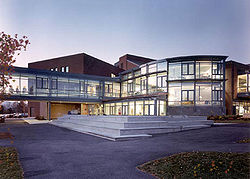
repository. The contemporary, green design building makes use of passive and active solar heating. Its south-southwest orintetation for reading rooms utilizes natural light. The LLC is built of terra cotta brick, Vermont gray granite, Vermont blue-gray slate, steel, and green-tinted glass. The LLC was designed by the architectural firm of Gossens Bachman Architects and has won numerous awards for its architecture and environmental efficiency. Awards include the 1997 American Institute of Architects
(AIA) Vermont "Excellence in Architecture Award." The LLC also houses the faculties of the Department of Humanities, and the Department of Writing and Literature. A skybrige links the LLC with Wilson Bentley Hall. The LLC has become a community centerpiece and serves as a gateway to the northwest side of the quadrangle. An informal outdoor amphitheater facing the quadrangle has become a popular outdoor social area in warmer weather.
to house the college's library. It is named for the philosopher and educator John Dewey
. The building is lit by natural light from a panoramic glass clerestory around the perimeter of the building. Today the building houses the office of the Dean of Students, the Student Association, Basement Medicine–the student newspaper, academic advising, and career placement offices.
s. The VAC augments exhibition space at the Julian Scott Memorial Gallery in the Dibden Center with a gallery for exhibiting works in progress and student projects. Exhibitions play a major role in both academic and student life at Johnson. Students have opportunities to show their work beginning in their freshman year. Exhibition programs support and expand the studio curriculum, providing students with frequent opportunities to share their work and receive input; and, by exhibiting faculty and visiting artists' work, providing insights into teachers’ approaches to making art and critique. Exhibitions in many mediums both of work produced within the college, and by work exhibited by visiting artists exposes students to a wide range of contemporary thinking and art-making methods. Fine arts majors in the freshman and sophomore levels most commonly exhibit work in the VAC. Students in their junior and senior years, especially those presenting thesis level work exhibit in the Julian Scott Memorial Gallery at the Dibden Center for the Arts.

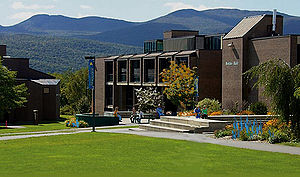
(1865–1931) who first photographed snowflakes in the nineteenth century in nearby Jericho, Vermont. Bentley brought an objective scientific eye to the examiniation of snow and ice crystals via hugely magnified images called photomicrographs. Bentley published a monograph titled Snow Crystals which documented more than 2000 snowflakes and ice crystals. Wilson Bentley Hall, designed by noted architect Robert Burley, houses the faculties of the Department of Mathematics, and the Department of Environmental and Health Sciences. A 200-seat lecture hall with digital projection facilities, an interactive television studio, and laboratories for biology, chemistry, physical sciences, cartography, and geographic information systems. Bentley Hall also houses a state-of-the-art interactive multimedia computer laboratory and is a designated National Science Foundation
research facility. The building also houses a meteorological station, and green house.
, located ten miles from Johnson in Eden, Vermont is a 1,000 acre (4 km²) tract of forest land owned and maintained by the college for scientific and educational study. A large, environmentally significant bog, and three large ponds dominate the physical landscape. The Babcock Nature Preserve is a natural laboratory for field biology, ornithology and environmental sciences courses. The summer field program at the Babcok Nature Preserve features a number of intensive courses designed to provide field experience in the environmental and natural sciences.
Liberal arts college
A liberal arts college is one with a primary emphasis on undergraduate study in the liberal arts and sciences.Students in the liberal arts generally major in a particular discipline while receiving exposure to a wide range of academic subjects, including sciences as well as the traditional...
, founded in 1828 by John Chesamore at Johnson in the U.S. state of Vermont
Vermont
Vermont is a state in the New England region of the northeastern United States of America. The state ranks 43rd in land area, , and 45th in total area. Its population according to the 2010 census, 630,337, is the second smallest in the country, larger only than Wyoming. It is the only New England...
. Johnson's president is Barbara E. Murphy
Council of Presidents
The Council of Presidents is the executive leadership body of the Vermont State Colleges , the governance organization for public colleges in the U.S. state of Vermont. The council is composed of a chancellor, the three vice presidents of the VSC, and the presidents of the five member colleges...
and its board chair is Gary M. Moore
Vermont State Colleges
The Vermont State Colleges is the U.S. state of Vermont's system of public colleges. It functions as a governance organization, and was created by act of the Vermont General Assembly in 1961...
.
History and governance

William Samuel Johnson
William Samuel Johnson was an early American statesman who was notable for signing the United States Constitution, for representing Connecticut in the United States Senate, and for serving as president of Columbia University.-Early career:...
(1727-1819), American jurist, statesman and educator. The town of Johnson, and a part of neighboring Cambridge, Vermont together once made up the King's College Tract
King's College Tract
The King's College Tract consisted of an area of forested land in the vicinity of the present towns of Cambridge and Johnson in the U.S. state of Vermont. The tract was granted in 1764 by Lieutenant Governor Cadwallader Colden of the New York crown colony, in the name of King George III to the...
, a land grant chartered by King George III in 1774 for the eventual expansion of King's College in New York, today's Columbia University. Following the Declaration of Independence, and the emergence of the Vermont Republic
Vermont Republic
The term Vermont Republic has been used by later historians for the government of what became modern Vermont from 1777 to 1791. In July 1777 delegates from 28 towns met and declared independence from jurisdictions and land claims of British colonies in New Hampshire and New York. They also...
, the town was instead granted to William Samuel Johnson by Vermont's Council of Censors in 1782. Johnson represented Connecticut in the Continental Congress, and argued for Vermont's admission to the federal Union. He later became president of Columbia University. John Chesamore founded Johnson State College as Johnson Academy, a grammar school instructing students in Greek, Latin, algerbra and geometry. In 1867 the school became a Vermont state "normal school
Normal school
A normal school is a school created to train high school graduates to be teachers. Its purpose is to establish teaching standards or norms, hence its name...
", a term based on the French école normale – a school to educate teachers. Early on Johnson embraced the ideas of learning from experience, and the role of the student in directing some part of their curriculum. The college was among the first Vermont universities to introduce electives. Through the early to mid-twentieth century Johnson emerged as a college of the liberal arts and natural sciences.
A commitment to educating the whole student in an interdisciplinary manner, begun in the 1920s and 1930s, set in place a history of bringing visiting poets, playwrights, politicians, and artists to the college. That tradition continues, bringing filmmakers, political and spiritual leaders, and artists. Recent visitors to the campus include Japanese and Cuban drummers, New Orleans jazz musicians, and Buddhist monks who installed an environmental art work at Lower Pond.
The original campus was built in the village of Johnson and over time, the college expanded; slowly building higher upon what is now called College Hill, finally settling upon a plateau above the village with a view of Sterling Mountain and the Sterling Mountain Range. Today the college is a part of the Vermont State Colleges
Vermont State Colleges
The Vermont State Colleges is the U.S. state of Vermont's system of public colleges. It functions as a governance organization, and was created by act of the Vermont General Assembly in 1961...
, a consortium of five colleges governed by a common board of trustees, chancellor, and Council of Presidents
Council of Presidents
The Council of Presidents is the executive leadership body of the Vermont State Colleges , the governance organization for public colleges in the U.S. state of Vermont. The council is composed of a chancellor, the three vice presidents of the VSC, and the presidents of the five member colleges...
, each college with its own president and deans.
Education by engagement
Johnson emphasizes the self development of undergraduate students with what the college terms "education by engagement." The student is engaged not solely on her or his degree program but as an adult citizen with emphasis on their place in, and contribution to, their society, nation, and world. After a year of interdisciplinary study, students file a Plan of Study during the sophomore year. This becomes a guiding yet flexible road map for completion of students' degree work. Degree programs include the natural sciences, business, fine and performing arts, education, mathematics, literature, health sciences, writing and literature, and hospitality and tourism management. Precepts of Vermont educator-philosopher John DeweyJohn Dewey
John Dewey was an American philosopher, psychologist and educational reformer whose ideas have been influential in education and social reform. Dewey was an important early developer of the philosophy of pragmatism and one of the founders of functional psychology...
(1859-1952) inform Johnson's emphasis on students' self evolution with emphasis on "learning by doing" and "learning by teaching." The college emphasizes the individual's civic contribution to their larger society.

Faculty and students
The college has a faculty-student ratio of 1:14. Ninety-one percent of the college's faculty hold a Ph.D. or equivalent doctorate level terminal degree in their area of instruction. Nearly 60% of undergraduate students come from Vermont, with approximately 40% coming from other U.S. states and more than a dozen nations.Graduate programs at Johnson include an M.F.A. in Studio Arts, a Master of Arts in Education, and Master of Arts in Counseling. Parts of these programs can be completed with a low residency requirement. Portions of the M.F.A. in Studio Arts program includes course work in conjunction with the Vermont Studio Center
Vermont Studio Center
The Vermont Studio Center is a non-profit organization located in the town of Johnson in the U.S. state of Vermont. VSC conducts the largest fine arts and writing residency program in the U.S., with a significant population of international artists in residency...
, located in the village of Johnson.
The Dibden Center for the Arts
Named for Arthur J. Dibden, president of Johnson State College 1967-69, Dibden oversaw the expansion and development of the fine and performing arts programs. The art center is colloquially known simply as "Dib." The center is located on the southwest side of the campus and houses the college's Dance, Music, and Theater programs as well as gallery exhibition space for the Fine Arts programs. The striking late modernist building, whose sculptural roofline echoes the contours of the Sterling Mountain Range–its backdrop to the south, is the work of architect Robert Burley. Burley apprenticed in the studio of Eero SaarinenEero Saarinen
Eero Saarinen was a Finnish American architect and industrial designer of the 20th century famous for varying his style according to the demands of the project: simple, sweeping, arching structural curves or machine-like rationalism.-Biography:Eero Saarinen shared the same birthday as his father,...
. The large 500-seat Dibden Theater with a 44' proscenium stage is the centerpiece of the performing arts facilities at the center. Excellent acoustics are achieved by a system of hardwood baffles along the walls and ceilings. Practice and instruction rooms wrap around the theater and the Julian Scott
Julian Scott
Julian A. Scott , he was born in Johnson, Vermont, and served as a Union Army drummer during the American Civil War where he received America's highest military decoration the Medal of Honor for his actions at the Battle of Lee's Mills; he was also an American painter and Civil War...
Memorial Gallery on the front of the center showcases exhibitions of fine art and design by the college's fine art students as well as travelling exhibitions and the work of visiting artists. The Dibden Center for the Arts houses the faculties of the Department of Music and the Department of Theater, a recording studio, music studios, practice rooms, classrooms and a piano laboratory. Recitals and concerts, theater and contemporary dance performances, and open rehearsals bring performing arts into the daily life of the college. The Vermont Symphony Orchestra
Vermont Symphony Orchestra
The Vermont Symphony Orchestra is a symphony orchestra based in, and supported in part by, the U.S. state of Vermont. It is a 501 corporation. It is one of the few, and the oldest, state-supported symphony orchestras in the United States....
performs regularly at the center. Several performing arts series available to the college community, are also available to the public by subscription. The Dibden Center is an important fine and performing arts venue for all of Vermont. One of the best aspects of Dibden is the fact that it is fully student run, both working Front of House and backstage, so there is always learning and working opportunity for students that seek work opportunities and those who would like to learn more about the theater.

Library and Learning Center
Johnson's Library and Learning Center (LLC) opened in 1996 and incorporates the collections of the older John Dewey Library with expanded collections and new technology. The print collection includes 130,000+ volumes and over 700 journals and periodical. The LLC houses the largest collections of fine arts publications in Vermont and is a designated National Archives and Records AdministrationNational Archives and Records Administration
The National Archives and Records Administration is an independent agency of the United States government charged with preserving and documenting government and historical records and with increasing public access to those documents, which comprise the National Archives...
repository. The contemporary, green design building makes use of passive and active solar heating. Its south-southwest orintetation for reading rooms utilizes natural light. The LLC is built of terra cotta brick, Vermont gray granite, Vermont blue-gray slate, steel, and green-tinted glass. The LLC was designed by the architectural firm of Gossens Bachman Architects and has won numerous awards for its architecture and environmental efficiency. Awards include the 1997 American Institute of Architects
American Institute of Architects
The American Institute of Architects is a professional organization for architects in the United States. Headquartered in Washington, D.C., the AIA offers education, government advocacy, community redevelopment, and public outreach to support the architecture profession and improve its public image...
(AIA) Vermont "Excellence in Architecture Award." The LLC also houses the faculties of the Department of Humanities, and the Department of Writing and Literature. A skybrige links the LLC with Wilson Bentley Hall. The LLC has become a community centerpiece and serves as a gateway to the northwest side of the quadrangle. An informal outdoor amphitheater facing the quadrangle has become a popular outdoor social area in warmer weather.
John Dewey Campus Center
The John Dewey Campus Center on the south side of the quadrangle was built in 1963 in the International StyleInternational style (architecture)
The International style is a major architectural style that emerged in the 1920s and 1930s, the formative decades of Modern architecture. The term originated from the name of a book by Henry-Russell Hitchcock and Philip Johnson, The International Style...
to house the college's library. It is named for the philosopher and educator John Dewey
John Dewey
John Dewey was an American philosopher, psychologist and educational reformer whose ideas have been influential in education and social reform. Dewey was an important early developer of the philosophy of pragmatism and one of the founders of functional psychology...
. The building is lit by natural light from a panoramic glass clerestory around the perimeter of the building. Today the building houses the office of the Dean of Students, the Student Association, Basement Medicine–the student newspaper, academic advising, and career placement offices.
Visual Arts Center
Johnson's Visual Arts Center (VAC) houses the college's Visual Arts Programs, with studios for design, drawing, painting, printmaking, photography, sculpture, ceramics and woodworking. The Digital Imaging Laboratory (DIL) is also located here with state-of-the-art oversized high resolution laser CMYK and Inkjet printerInkjet printer
An inkjet printer is a type of computer printer that creates a digital image by propelling droplets of ink onto paper. Inkjet printers are the most commonly used type of printer and range from small inexpensive consumer models to very large professional machines that can cost up to thousands of...
s. The VAC augments exhibition space at the Julian Scott Memorial Gallery in the Dibden Center with a gallery for exhibiting works in progress and student projects. Exhibitions play a major role in both academic and student life at Johnson. Students have opportunities to show their work beginning in their freshman year. Exhibition programs support and expand the studio curriculum, providing students with frequent opportunities to share their work and receive input; and, by exhibiting faculty and visiting artists' work, providing insights into teachers’ approaches to making art and critique. Exhibitions in many mediums both of work produced within the college, and by work exhibited by visiting artists exposes students to a wide range of contemporary thinking and art-making methods. Fine arts majors in the freshman and sophomore levels most commonly exhibit work in the VAC. Students in their junior and senior years, especially those presenting thesis level work exhibit in the Julian Scott Memorial Gallery at the Dibden Center for the Arts.


Wilson Bentley Science Hall
Named for the scientist-artist, Wilson BentleyWilson Bentley
Wilson Alwyn "Snowflake" Bentley , born in Jericho, Vermont, United States is one of the first known photographers of snowflakes. He perfected a process of catching flakes on black velvet in such a way that their images could be captured before they either melted or sublimed.-Biography:Bentley was...
(1865–1931) who first photographed snowflakes in the nineteenth century in nearby Jericho, Vermont. Bentley brought an objective scientific eye to the examiniation of snow and ice crystals via hugely magnified images called photomicrographs. Bentley published a monograph titled Snow Crystals which documented more than 2000 snowflakes and ice crystals. Wilson Bentley Hall, designed by noted architect Robert Burley, houses the faculties of the Department of Mathematics, and the Department of Environmental and Health Sciences. A 200-seat lecture hall with digital projection facilities, an interactive television studio, and laboratories for biology, chemistry, physical sciences, cartography, and geographic information systems. Bentley Hall also houses a state-of-the-art interactive multimedia computer laboratory and is a designated National Science Foundation
National Science Foundation
The National Science Foundation is a United States government agency that supports fundamental research and education in all the non-medical fields of science and engineering. Its medical counterpart is the National Institutes of Health...
research facility. The building also houses a meteorological station, and green house.
The Babcock Nature Preserve
The Babcock Nature PreserveBabcock Nature Preserve
The Babcock Nature Preserve is located in Eden, Vermont. The preserve comprises a 1,000-acre tract of boreal forest land owned and maintained by Johnson State College and the Vermont State Colleges for scientific and educational study....
, located ten miles from Johnson in Eden, Vermont is a 1,000 acre (4 km²) tract of forest land owned and maintained by the college for scientific and educational study. A large, environmentally significant bog, and three large ponds dominate the physical landscape. The Babcock Nature Preserve is a natural laboratory for field biology, ornithology and environmental sciences courses. The summer field program at the Babcok Nature Preserve features a number of intensive courses designed to provide field experience in the environmental and natural sciences.
External links
- Johnson State College official website
- School Profile and Stats - External info on attendance, student body, test averages, etc.
- Jonson State College is one of the five colleges in the Vermont State Colleges consortium
Related resources
- List of colleges and universities in the United States
- List of colleges and universities in Vermont

